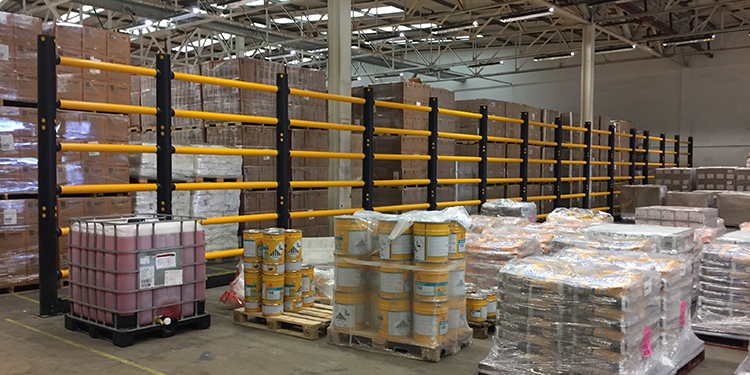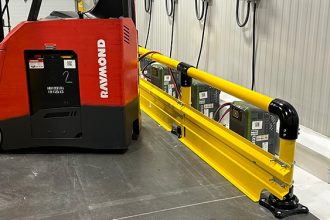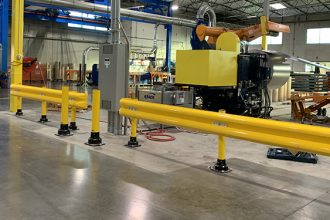Topple Barriers Protect Pedestrians From Falling Floor-Stacked Loads

Floor- or block-stacked loads — which can include palletized goods, individual cases, bulk containers, or large products (such as paper rolls) — are often stored in warehouses or manufacturing facility spaces where traditional pallet racking is not suitable. However, instead of being stored on industrial steel storage racking, these particular loads are placed directly on the floor, with additional loads stacked on top of the first. They can, in some instances, reach heights of 20-plus feet above ground level.
When stacked loads exceed heights of 48 inches, there is an increased injury risk to pedestrians of items possibly falling off the stack and potentially striking them should they be in proximity to the area. Pedestrians aren’t the only consideration, either. Additional products or facility machinery may also need protection from falling items. To avoid these dangerous scenarios, best practice recommends the installation of topple protection barriers between stacking zones and potentially vulnerable areas such as pedestrian pathways, stored inventory, or equipment.
What is a topple protection barrier? It’s similar in appearance to a tall fence yet has been engineered to be both strong and resilient enough to withstand the impact of falling stacked objects, while preventing them from tumbling into areas where pedestrians, other products, or machinery are located.
Topple barriers can be constructed from a variety of materials, including mesh safety netting, steel mesh panels, or polymer or steel high level rails. What is the best topple barrier for your application? What material should be used in the topple barrier at your facility? To answer these questions — and to make sure you’re properly protecting your team and other property — take the following steps:
- Consult with a protective guarding expert. While you know your product and your facility, protective guarding experts know what needs to be considered when planning your topple barrier solution. With their guidance, you can determine the optimal barrier based on all the factors involved.
- Know the materials being stacked. Products with sharp edges are more likely to tear through mesh netting. Small items may slip between polymer or steel barrier rails. In certain applications, an enclosed, tunnel-like barrier structure can be constructed from one or more of these topple barrier materials, thereby protecting pedestrians from items that might fall from a floor-stacked load.
- Determine the maximum weight of the load. Mesh netting is more appropriate to contain lighter weight items, such as empty cartons or small products. Heavier or extremely dense items, such as paper rolls or full pallets of product, may require polymer high level solutions or steel barriers to prevent items from falling into a pedestrian path or other vulnerable areas. Steel, however, is more likely to be permanently deformed by a falling object, frequently making it a one-time use product. Polymer barrier rails designed to absorb and dissipate the force of the falling load by flexing and returning to their original shape may be the most appropriate solution for mid-range load weights.
- Measure the maximum height of the load. The taller the stacked load height, the higher the topple barrier will need to be. However, the taller the barrier, the more important it becomes to carefully consider the applied load. That is due to the increased bending moment that occurs from — and the structure’s reaction to — the application of an external force, such as a heavy item falling off the stack. The strength of that force must be factored when selecting the optimal barrier material, determining its design, and setting the spacing between the posts.
- Understand the use of motorized vehicles, such as forklifts, in the area. If fork encroachment within the vulnerable area behind the topple barrier is also of concern, pedestrian and traffic barriers or industrial pedestrian guardrail with fork protection should be integrated into the topple barrier system. This allows the topple barrier to serve multiple functions: stopping items from falling, deflecting low level forklift impacts, and preventing fork penetration intrusion.
By understanding these factors, you can select the best topple barrier for your facility, enabling better protection of pedestrians, products, and other facility elements from falling floor-stacked items.
Want more details about topple barriers and other equipment to protect your facility’s personnel? The members of the Protective Guarding Manufacturers Association (ProGMA) are available for guidance and recommendations. The ProGMA is in the process of writing a testing standard for topple protection barrier products with a projected publication date of 2023.



